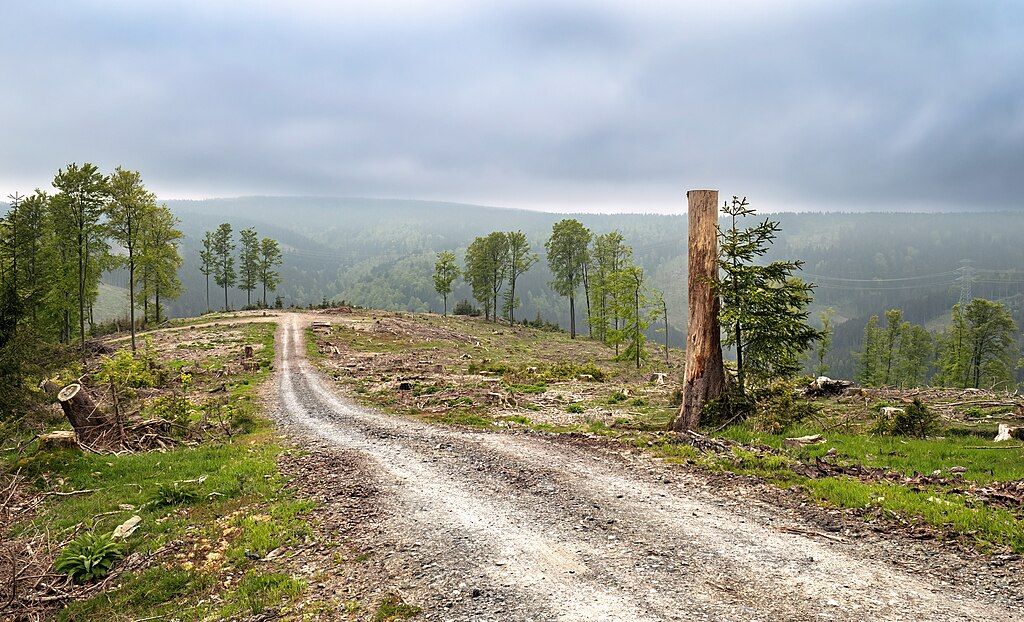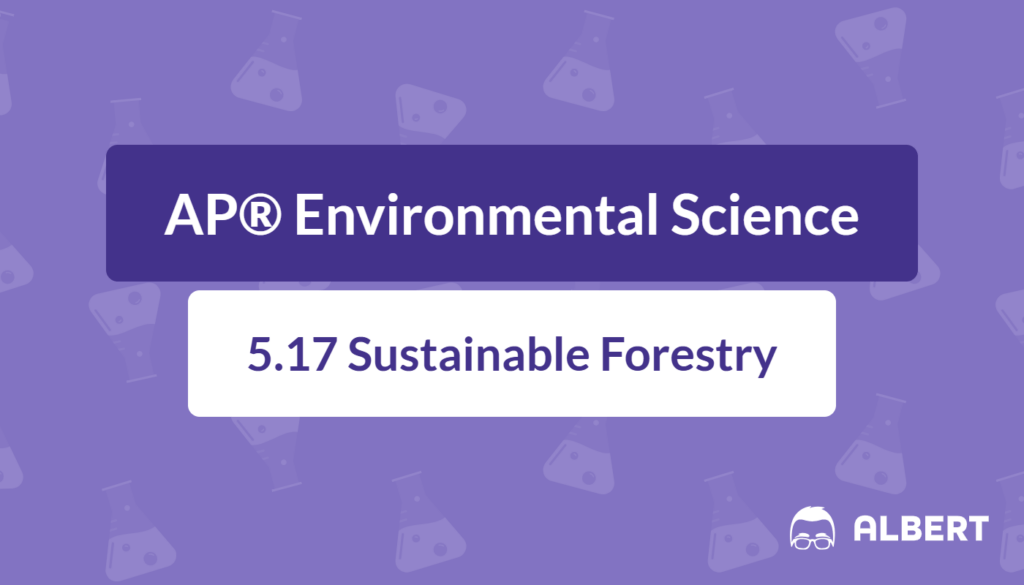What We Review
Introduction
Forests are vital components of the Earth’s ecosystems, providing clean air, regulating climate, and providing habitats for countless species. They also supply essential materials such as timber, food, and medicinal resources. However, many forested regions face pressures from human activities that undermine their long-term health. Sustainable forestry seeks to balance human needs with ecological preservation. By understanding how sustainable practices work, students of AP® Environmental Science can gain insights into how forests may be conserved for future generations.
Therefore, it is crucial to explore how forests function, why deforestation occurs, and how reforestation efforts can help restore damaged ecosystems. Learning about integrated pest management (IPM) and prescribed burns further highlights ways to maintain forest health without sacrificing economic value. Altogether, sustainable forestry relies on methods proven to mitigate harm, promote biodiversity, and ensure that forests continue benefiting both people and the planet.
Understanding Deforestation
Deforestation occurs when large forested areas are removed or cleared of trees, often to make space for agricultural land, infrastructure, or urban development. This process reduces biodiversity and disrupts ecological balance. Additionally, the loss of trees diminishes carbon storage capacity, causing an increase in atmospheric carbon dioxide and contributing to global climate change. Moreover, when forests disappear, soil erosion can worsen and local water cycles can be disturbed.
Causes and Consequences
- Agricultural Expansion: Converting forest land into cropland is widespread, particularly for commodities like soy or palm oil.
- Logging: Commercial timber extraction leads to forest fragmentation, which can open new areas to further clearing.
- Infrastructure Development: Building roads and cities expands human settlement into forested regions.
Transitioning to the consequences, deforestation shrinks habitats for countless species, which can cause local extinctions. It also reduces the ability of forests to store carbon, potentially accelerating climate change. Furthermore, local communities often suffer from decreased freshwater supplies and lost resources.

Radomianin, CC BY-SA 4.0, via Wikimedia Commons
Example: Deforestation in the Amazon Rainforest
One of the most prominent cases of deforestation takes place in the Amazon Rainforest, where vast tracts of land are cleared for agriculture and cattle ranching. Satellite imagery reveals dramatic changes over time, illustrating how roads facilitate more extensive deforestation. As a result, local ecosystems face soil degradation, reduced water quality, and a decline in species diversity. This situation highlights the urgent need for sustainable practices when managing global forests.
The Importance of Reforestation
Reforestation is the purposeful replanting of trees in areas where forests have been removed. It serves to restore the structure and function of these ecosystems. Not only does reforestation improve habitats for wildlife, but it also stores carbon, reduces soil erosion, and stabilizes local climate patterns. Therefore, reforestation campaigns often become critical steps in mitigating the impacts of past deforestation.
Benefits of Reforestation
- Carbon Sequestration: Growing trees capture CO_2, helping to offset greenhouse gas emissions.
- Biodiversity Conservation: Forest ecosystems support various plant, animal, and microbial species.
- Soil Erosion Control: Tree roots stabilize soil, preventing it from being carried away by wind or water.
- Water Cycle Regulation: Vegetation helps maintain stable water flows, reducing flood risks and enhancing groundwater recharge.
Example: Steps in a Successful Reforestation Project
Restoring a forested area typically involves several key steps:
- Site Assessment: Examine soil quality, existing vegetation, and climate conditions to choose appropriate tree species.
- Seedling Selection: Use native tree species adapted to local conditions for the highest survival rate.
- Planting Plan: Decide how densely to plant and if any specific arrangement is needed to promote healthy growth.
- Maintenance Schedule: Implement watering, weeding, and pest control to give young trees the best start.
Throughout this process, continuous monitoring ensures that the project remains on track. For instance, periodic measurements of tree height, canopy coverage, or survival rates can guide future improvements.
Sustainable Forestry Practices
Sustainable forestry aims to harvest wood while maintaining the health and diversity of forest ecosystems. In many regions, overharvesting depletes natural resources, causing long-term damage. Therefore, ecologically sustainable forestry techniques consider tree species, population density, and soil health when determining the scale and frequency of timber extraction.
Overview of Sustainable Forestry
In ethical forestry operations, carefully selected trees are removed in rotations, allowing younger ones to mature in their place. This approach contrasts with clear-cutting, where large swaths of forest are entirely felled. Sustainable methods also often prioritize worker safety, fair labor, and community engagement. Ultimately, these measures help sustain forest stands for the future.
Example: Traditional vs. Sustainable Logging Methods
- Traditional Logging or Clear-Cutting:
- Removes all or most trees in an area.
- Disrupts habitats significantly.
- Exposes the soil to erosion.
- Sustainable Logging (Selective Cutting):
- Removes specific mature trees while leaving others to grow.
- Preserves the canopy structure, which protects soil and smaller species.
- Continues to store carbon while allowing for economic gains from timber sales.
By adopting sustainable methods, timber industries can meet demands without permanently damaging forests.
Integrated Pest Management (IPM)
Integrated Pest Management is a strategy for controlling pests—with minimal harm to the environment—by combining multiple techniques. In forest management, IPM includes biological controls, chemical treatments when necessary, and cultural practices that help prevent severe outbreaks. Seeing that insects and diseases can rapidly spread in weakened forests, IPM supports healthy trees while protecting biodiversity.
Importance of IPM in Protecting Forests
Pests and pathogens can severely reduce the productivity of a forest by destroying leaves, bark, or roots. Moreover, infestations can threaten rare species and further degrade ecosystems already stressed by deforestation. Through IPM, managers continually monitor pest populations, apply targeted controls, and evaluate the outcomes.
Example: Steps in Implementing an IPM Plan
- Monitoring and Identification: Regularly inspect tree canopies and trunks to detect early signs of pests or diseases.
- Threshold Determination: Define when intervention is needed based on pest density or damage levels.
- Control Methods: Incorporate biological controls (e.g., introducing natural predators), physical traps, or chemical agents with low environmental impact.
- Evaluation and Adjustment: Study how effective each intervention is and refine the plan accordingly.
Transitioning these principles from theory to practice highlights the thoughtful approach required for forest protection.
The Role of Prescribed Burning
Prescribed burning, also called controlled burning, is a forestry method where areas of woodland or grassland are set on fire under planned conditions. This practice reduces dead organic material on the forest floor, which in turn lowers the risk of large-scale, uncontrolled wildfires. Beyond that, prescribed burns can help certain fire-adapted species germinate and maintain ecological balance.
Benefits and Risks of Prescribed Burning
- Benefits:
- Reduces fuel loads, decreasing the likelihood of catastrophic wildfires.
- Releases nutrients stored in dead plant matter.
- Encourages new growth among species that thrive after fire events.
- Risks:
- Requires careful control of wind, humidity, and temperature to prevent accidents.
- Smoke emissions can affect nearby communities.
- May temporarily disrupt local wildlife habitats.
Example: How to Carry Out a Prescribed Burn Safely
To carry out a prescribed burn:
- Develop a Burn Plan: Identify goals, potential hazards, and the desired season or weather conditions.
- Obtain Permits: Follow local regulations and secure any necessary approvals from fire authorities.
- Prepare the Site: Remove debris or create fire breaks to contain the flames.
- Monitor Conditions: Check wind speed, humidity, and forecast changes.
- Execute the Burn: Ignite sections in a planned sequence, ensuring the fire remains within set boundaries.
- Post-Burn Assessment: Evaluate objectives and watch for remaining hot spots.
Therefore, prescribed burning can be effective but must be approached with expertise and caution.
Conclusion
Forests around the world face threats from human activities and natural hazards. However, sustainable forestry methods demonstrate how forests can be used responsibly. By mitigating deforestation, restoring degraded areas through reforestation, and employing strategies like integrated pest management, healthy forests can thrive for future generations. Likewise, prescribed burning remains a powerful tool to maintain ecological balance, although it demands careful oversight.
In practice, sustainable forestry calls for thoughtful decision-making that balances economic, social, and environmental interests. Local communities, global stakeholders, and policymakers should collaborate to promote practices that protect forest ecosystems. Recognizing the value of these methods creates opportunities to maintain biodiversity, slow climate change, and preserve essential resources.
Important Vocabulary
- Deforestation: The removal or clearing of trees in an area, often for agricultural or developmental purposes.
- Reforestation: The process of replanting trees in areas where forests have been depleted or destroyed.
- Integrated Pest Management (IPM): A strategy for controlling pests using multiple techniques to minimize harm to the environment.
- Prescribed Burn: A controlled fire set intentionally under specific conditions to manage forest health and reduce wildfire risk.
- Selective Cutting: A logging method that removes specific trees while leaving the rest of the forest intact, aiding sustainability.
Sharpen Your Skills for AP® Environmental Science
Are you preparing for the AP® Environmental Science test? We’ve got you covered! Try our review articles designed to help you confidently tackle real-world AP® Environmental Science problems. You’ll find everything you need to succeed, from quick tips to detailed strategies. Start exploring now!
- AP® Environmental Science: 5.14 Review
- AP® Environmental Science: 5.15 Review
- AP® Environmental Science: 5.16 Review
Need help preparing for your AP® Environmental Science exam?
Albert has hundreds of AP® Environmental Science practice questions, free response, and full-length practice tests to try out.








